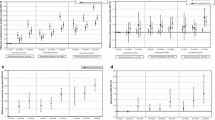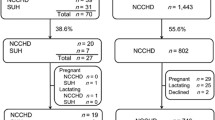Abstract
Introduction
Women with former preeclampsia (exPE) develop chronic hypertension 4 times more often than healthy parous controls. Women, destined to develop remote chronic hypertension, had increased left ventricular mass index (LVMI) and diastolic blood pressure (BP) prior to the onset of hypertension as compared to those remaining normotensive. However, longitudinal data on the progress of this increased LVMI in women destined to develop hypertension are lacking.
Methods
We included 20 women with exPE and 8 parous controls. At both 1- and 14-year postpartum (pp), we performed cardiac ultrasound and determined circulating levels of the metabolic syndrome variables. Of 14-year pp, 7 (35%) former patients had developed chronic hypertension. We compared these 7 former patients with both the 13 former patients who remained normotensive and the 8 parous controls using the Mann-Whitney U test and Kruskal-Wallis analysis.
Results
Women with hypertensive exPE differed from their normotensive counterparts by a higher incidence of early-onset preeclampsia (PE) in their index pregnancy and a higher rate of recurrence in next pregnancies. At 1-year pp, they also had high/normal BP and higher fasting insulin levels. At 14 years pp, the relative left ventricular wall thickness was higher, and the E/A ratio was lower, in the hypertensive group relative to those remaining normotensive.
Conclusion
Women with exPE are at increased risk of developing chronic hypertension, when (1) the PE in the index pregnancy had an early-onset and/or recurred in next pregnancies and (2) the 1-year pp. Blood pressure was high normal. We also noticed that at 14 years pp, the hypertensive group showed signs of concentric left ventricular remodeling along with a decreased E/A ratio.
Similar content being viewed by others
References
Hernandez-Diaz S, Toh S, Cnattingius S. Risk of pre-eclampsia in first and subsequent pregnancies: prospective cohort study. BMJ. 2009;338:b2255.
Adams EM, Macgillivray I. Long-term effect of preeclampsia on blood-pressure. Lancet. 1961;2(7217):1373–1375.
Carty DM, Defies C, Dominiczak AF. Preeclampsia and future maternal health. J Hypertens. 2010;28(7):1349–1355.
Bellamy L, Casas JP, Hingorani AD, Williams DJ. Pre-eclampsia and risk of cardiovascular disease and cancer in later life: systematic review and meta-analysis. BMJ. 2007;335(7627):974.
Myatt L, Webster RP. Vascular biology of preeclampsia. J Thromb Haemost. 2009;7(3):375–384.
Ghossein-Doha C, Peeters L, van Heijster S, et al. Hypertension after preeclampsia is preceded by changes in cardiac structure and function. Hypertension. 2013;62(2):382–390.
Davila DF, Donis JH, Odreman R, Gonzalez M, Landaeta A. Patterns of left ventricular hypertrophy in essential hypertension: should echocardiography guide the pharmacological treatment? Int J Cardiol. 2008;124(2):134–138.
Ganau A, Devereux RB, Roman MJ, et al. Patterns of left ventricular hypertrophy and geometric remodeling in essential hypertension. J Am Coll Cardiol. 1992;19(7):1550–1558.
Barden AE, Beilin LJ, Ritchie J, Walters BN, Michael C. Does a predisposition to the metabolic syndrome sensitize women to develop pre-eclampsia? J Hypertens. 1999;17(9): 1307–1315.
Harskamp RE, Zeeman GG. Preeclampsia: at risk for remote cardiovascular disease. Am J Med Sci. 2007;334(4):291–295.
Perry IJ, Beevers DG. The definition of pre-eclampsia. Br J Obstet Gynaecol. 1994;101(7):587–591.
Visser GH, Eilers PH, Elferink-Stinkens PM, Merkus HM, Wit JM. New Dutch reference curves for birthweight by gestational age. Early Hum Dev. 2009;85(12):737–744.
Spaanderman ME, Van Beek E, Ekhart TH, et al. Changes in hemodynamic parameters and volume homeostasis with the menstrual cycle among women with a history of preeclampsia. Am J Obstet Gynecol. 2000;182(5):1127–1134.
Expert Panel on Detection E, Treatment of High Blood Cholesterol in A. Executive Summary of The Third Report of The National Cholesterol Education Program (NCEP) Expert Panel on Detection, Evaluation, And Treatment of High Blood Cholesterol In Adults (Adult Treatment Panel III). JAMA. 2001;285(19):2486–2497.
Bonora E, Targher G, Alberiche M, et al. Homeostasis model assessment closely mirrors the glucose clamp technique in the assessment of insulin sensitivity: studies in subjects with various degrees of glucose tolerance and insulin sensitivity. Diabetes Care. 2000;23(1):57–63.
DuBois D, DuBois EF. A formula to estimate the approximate surface area if height and weight be known. Arch Int Med. 1916;17:863–871.
Devereux RB, Cásale PN, Kligfield P, et al. Performance of primary and derived M-mode echocardiographic measurements for detection of left ventricular hypertrophy in necropsied subjects and in patients with systemic hypertension, mitral regurgitation and dilated cardiomyopathy. Am J Cardiol. 1986;57(15): 1388–1393.
de Simone G, Daniels SR, Devereux RB, et al. Left ventricular mass and body size in normotensive children and adults: assessment of allometric relations and impact of overweight. J Am Coll Cardiol. 1992;20(5):1251–1260.
Allison PD. Missing data techniques for structural equation modeling. J Abnorm Psychol. 2003;112(4):545–557.
Melchiorre K, Sutherland GR, Liberati M, Tbilaganathan B. Preeclampsia is associated with persistent postpartum cardiovascular impairment. Hypertension. 2011;58(4):709–715.
Evans CS, Gooch L, Flotta D, et al. Cardiovascular system during the postpartum state in women with a history of preeclampsia. Hypertension. 2011;58(1):57–62.
Chobanian AV, Bakris GL, Black HR, et al. The seventh report of the joint national committee on prevention, detection, evaluation, and treatment of high blood pressure: the JNC 7 report. JAMA. 2003;289(19):2560–2572.
Spaan JJ, Sep SJ, van Balen VL, Spaanderman ME, Peeters LL. Metabolic syndrome as a risk factor for hypertension after preeclampsia. Obstet Gynecol. 2012;120(2 pt 1):311–317.
Solomon CG, Seely EW. Brief review: hypertension in pregnancy: a manifestation of the insulin resistance syndrome? Hypertension. 2001;37(2):232–239.
Author information
Authors and Affiliations
Corresponding author
Rights and permissions
About this article
Cite this article
Ghossein-Doha, C., Spaanderman, M., van Kuijk, S.M.J. et al. Long-Term Risk to Develop Hypertension in Women With Former Preeclampsia: A Longitudinal Pilot Study. Reprod. Sci. 21, 846–853 (2014). https://doi.org/10.1177/1933719113518989
Published:
Issue Date:
DOI: https://doi.org/10.1177/1933719113518989




